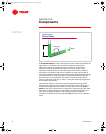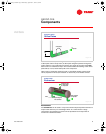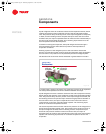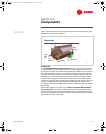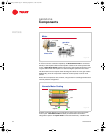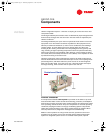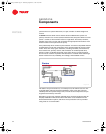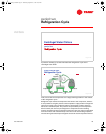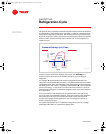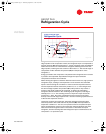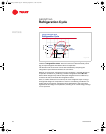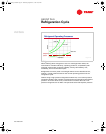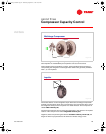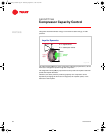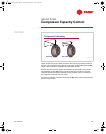
16 TRG-TRC010-EN
notes
period two
Refrigeration Cycle
The pressure drop created by the second expansion device lowers the pressure
and temperature of the refrigerant to evaporator conditions, causing a portion
of the liquid refrigerant to evaporate. The resulting mixture of liquid and vapor
enters the evaporator. In the evaporator, the liquid refrigerant boils as it absorbs
heat from water and the resulting vapor is drawn back to the compressor to
repeat the cycle.
The pressure-enthalpy chart plots the properties of a refrigerant—refrigerant
pressure (vertical axis) versus enthalpy (horizontal axis). Enthalpy is a
measure of the heat content, both sensible and latent, per pound [kg] of
refrigerant.
For example, A represents the heat content of saturated
liquid
HCFC-123
refrigerant at 5 psia [0.034 MPa] and 34°F [1.1°C]. B represents the heat content
of saturated
vapor
HCFC-123 refrigerant at the same pressure and temperature.
The difference in heat content, or enthalpy, between A and B—that is, 76.9 Btu/
pound [179.4 kJ/kg]—is the amount of heat required to transform 1 pound of
saturated liquid refrigerant to saturated refrigerant vapor at the same pressure
and temperature.
If the heat content of the refrigerant at any pressure falls to the right of the
curve, the vapor is superheated. Similarly, if the heat content of the refrigerant
falls to the left of the curve, the liquid is subcooled. Finally, when the heat
content of the refrigerant falls inside the curve, the refrigerant exists as a
mixture of liquid and vapor.
Let’s plot the theoretical vapor-compression refrigeration cycle for a 2-stage
centrifugal water chiller on a pressure-enthalpy chart.
Pressure-Enthalpy (
p-h)
Chart
enthalpy
enthalpy
subcooled
subcooled
liquid
liquid
mixture of
mixture of
liquid and
liquid and
vapor
vapor
15.5 Btu/
15.5 Btu/
lb
lb
[201.0 kJ/kg]
[201.0 kJ/kg]
pressure
pressure
superheated
superheated
vapor
vapor
%
$
5
5
psia
psia
[0.034
[0.034
MPa
MPa
]
]
92.4 Btu/
92.4 Btu/
lb
lb
[380.4 kJ/kg]
[380.4 kJ/kg]
Figure 24
trgtrc010_book.book Page 16 Wednesday, September 1, 1999 10:39 AM



